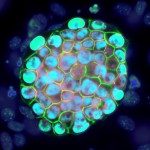Link to Pubmed [PMID] – 12457234
Cell Tissue Res. 2002 Dec;310(3):349-58
The apamin-sensitive component of the inhibitory response of the gastrointestinal musculature involves the small conductance Ca(2+)-activated K(+) channel SK3. Kit-immunoreactive (ir) interstitial cells of Cajal appear to be involved in nitrergic inhibition while the role of the recently described CD34-ir fibroblast-like cells adjacent to, but distinct from, the cells of Cajal remains elusive. The distribution of SK3 was studied by immunohistochemistry in the normal human gut, in motility disorders with a lack of cells of Cajal (infantile hypertrophic pyloric stenosis and Hirschsprung’s disease) and in mice deficient in cells of Cajal. SK3 immunoreactivity was observed exclusively in Kit-negative interstitial cells adjacent to, but distinct from, the Kit-ir interstitial cells of Cajal in the normal gut. The distribution of SK3-ir cells was not altered in conditions where cells of Cajal were lacking. These cells were CD34-ir fibroblast-like cells in the human gut and in the mouse stomach, while SK3-ir cells in the mouse intestine were CD34 negative. As SK channels are reportedly involved in inhibitory neurotransmission, our morphological observations suggest that SK3-ir interstitial cells, distinct from the Kit-ir interstitial cells of Cajal, may represent a novel cellular component in the control of excitability of the digestive musculature. Further studies will be required to directly address the function of these cells.

